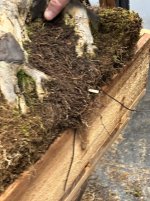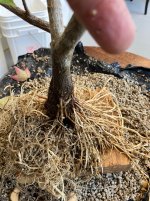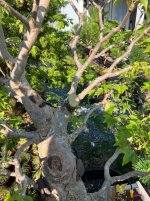Update on this project. A few weeks ago I had the help of some of my students to repot and check the progress on the Trident. It took some time to carefully remove the tree from the pot, explore the root ball to determine how things were progressing and plan the appropriate work during this repot.
Summary of findings.
1. the area that was addressed during the emergency repot approximately 18 months ago showed the healthiest root growth. This was the central core of the tree where the roots had all died. At the time of the emergency repot the outside edges and bottom showed soma healthy roots the core roots were dried out and dead and the major portion of the root ball was compacted with weaker roots as well.
2. The outer mat of roots on the sides and bottom were very healthy, however when the outside was trimmed off it was very apparent that the perimeter was still very compacted and showed weaker root system throughout. This area was addressed during the repot. The most compacted areas were carefully combed out with chopsticks to remove the majority of the compacted soil. This is a much older tree so the root ball was not bare rooted or washed. I chose to take a slower more cautious approach. By doing so, I hope to be able to continue some of the renovation work at earlier times in the process!
3. Clearly the tree will benefit from being placed in a grow box for several years to bring about the vigorous growth needed for the work planned. If recovery is as expected some work may even be possible this growing season.
Here are a series of photos to illustrate the comments above. The first photo shows the tree on the cart before we started. The last photo shows the condition of the tree today, three weeks after the repot. I will post some others separately to illustrate a couple of key points.
View attachment 591599View attachment 591600






















